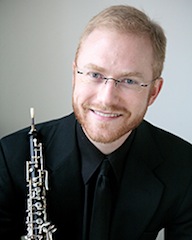
Oboist Parry Highlights Cincinnati Bach Festival

There is no more quintessential instrument of the Baroque period than the oboe, and the Cincinnati Bach Festival used that connection to forge a splendid concert Sunday afternoon (March 16) in Centennial Chapel at Christ Church Cathedral downtown.
Doing the honors splendidly on the oboe was Dwight Parry, principal oboist of the Cincinnati Symphony Orchestra, who joined baritone Jonathan Cooper, organist/harpsichordist Christopher Shepard and fellow members of the CSO for works by Johann Sebastian Bach and his sons.
On the program were J.S. Bach’s Cantata “Ich habe genug,” the Sonata for Oboe in G Minor by Carl Philipp Emanuel Bach, the Quartet in B-flat Major for Oboe and Strings by Johann Christian Bach, and to round out the program on a contemporary note, Peter Schickele’s “After Hearing Bach.” The latter was a Cincinnati premiere.
Intimate, barrel-vaulted Centennial Chapel (seating capacity 100) made an ideal setting for this music with its clean, warm acoustics.
C.P.E. Bach’s Oboe Sonata (formerly mis-attributed to J.S. Bach, Parry said) made a bright cheerful opener, with Shephard on harpsichord. This appealing music featured a bright, rippling first movement, a lyrical second movement with a lute-stop accompaniment by Shephard and a rapid, fluent finale, where Parry created an an almost trumpet-like sound.
“Ich habe genug” is one of Bach’s best-known cantatas (Cooper sang it using the obsolete “genung” spelling, which Bach himself used). Source of the canticle “Nunc dimittis” in the Anglican Evensong service (“Now lettest Thou Thy servant depart in peace”), it tells the biblical story of Simeon, the devout Jew who has been promised by God that he will not die before seeing the Messiah. The work utilizes oboe throughout.
Parry introduced the cantata in lovely, lyrical fashion, turning to the English horn for the central aria “Schlummert ein” (“Slumber now”). Cooper demonstrated a dark, caressing voice here, with just the right edge to it, turning nimble and joyous in the concluding aria, “Ich freue mich auf meinen Tod” (“Rejoicing do I greet my death”), with Parry accompanying in kind.
CSO colleagues Timothy Lees, violin, Christian Colberg, viola, and Susan Peterson, cello, joined Parry in Johann Christian Bach’s Quartet for Oboe and Strings. In two movements, it provided a cheerful counterpoint to the Cantata. Likewise, did Schickele’s “After Hearing Bach,” a 2007 work that draws on many strands of Bach to create a kind of 21st century mélange. Its five movements often seem headed in one direction only to end up (often suddenly) in another.
It is clearly a tongue-in-cheek work by Schickele, a classical composer otherwise known as P.D.Q. Bach -- “last and least” of the offspring of J.S. Bach” -- and the creator of numerous works of musical satire (most far more obvious than this one). You hear what sounds like one of Bach’s Brandenburg Concertos diffuse into something else or the odd quasi-romantic reflection. The second movement is very short, ending before it really makes a statement. The third movement opens fugally, per the Master, before becoming a spirited romp and there were some sudden, puzzling pauses in the final movement.
Still, it was great fun and the players seemed to enjoy it as much as the audience.
The Bach Festival continues March 23 at 6 p.m. at St. Thomas Episcopal Church in Terrace Park with “Bach Vespers for Lent,” and concludes March 29 at 3 p.m. in Centennial Chapel at Christ Church with cantatas by Dieterich Buxtehude and J.S. Bach. For information and tickets, visit collegiumcincinnati.org